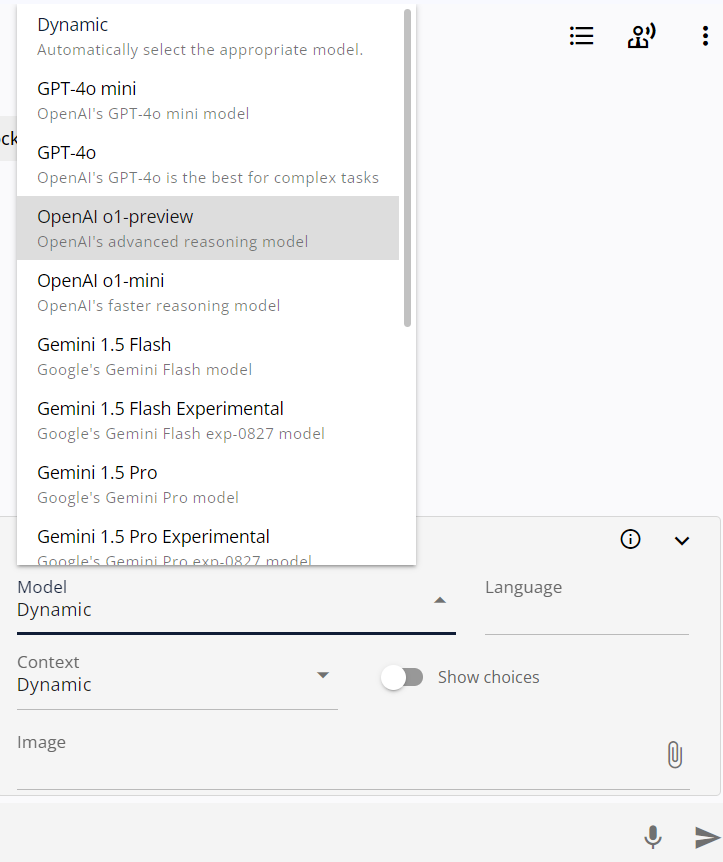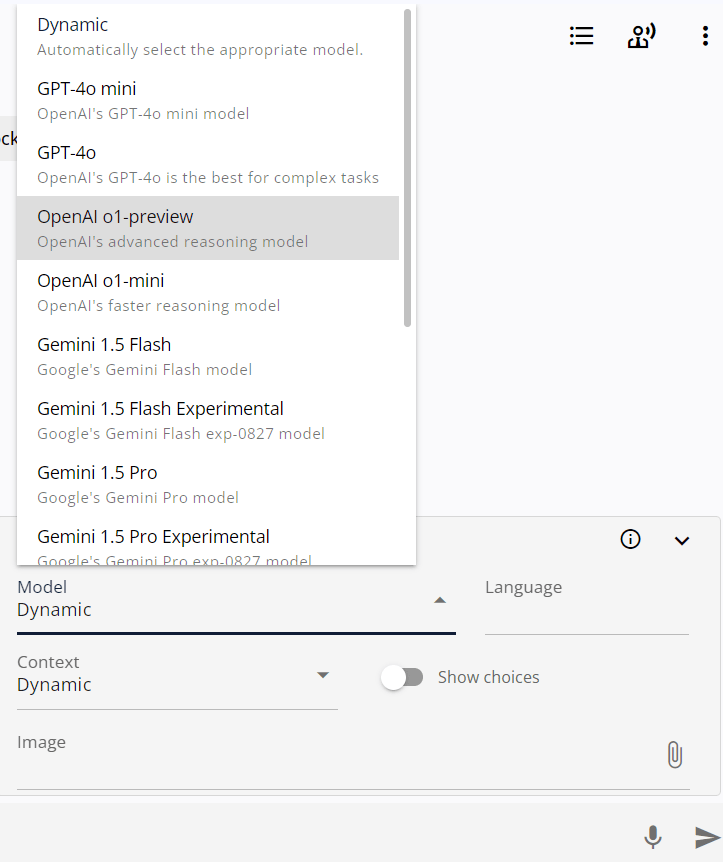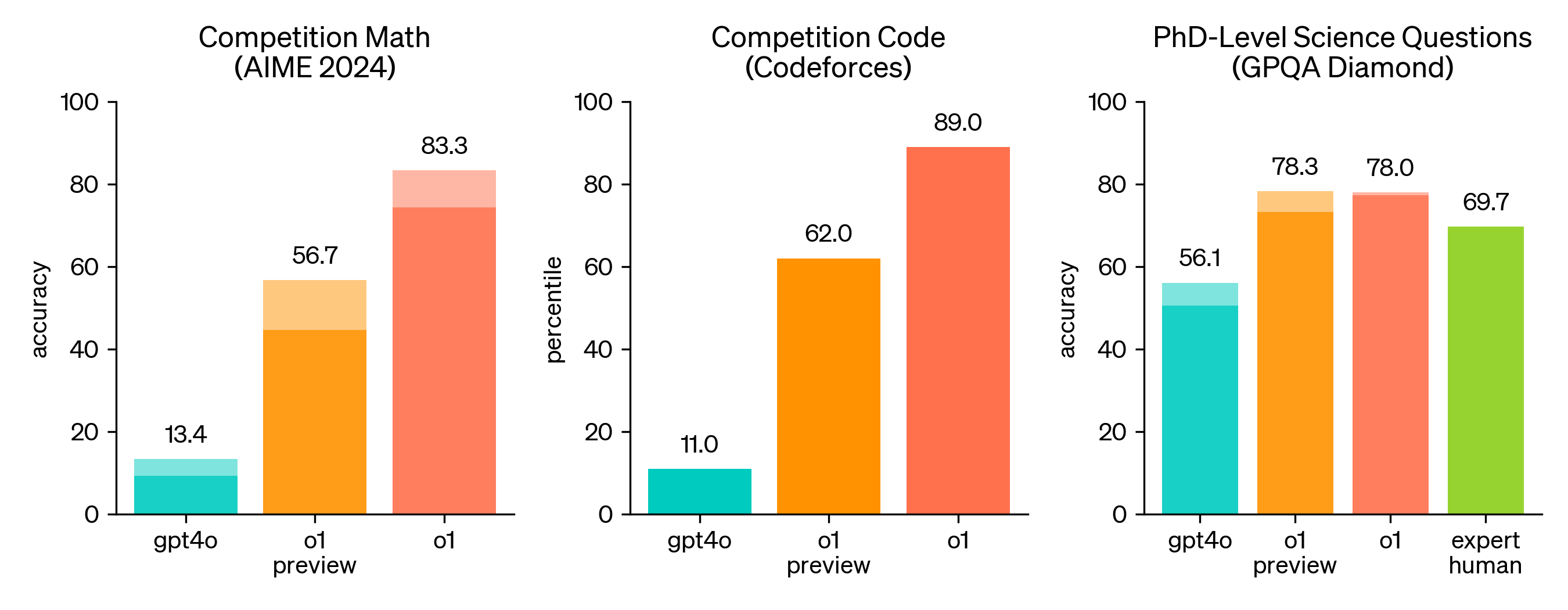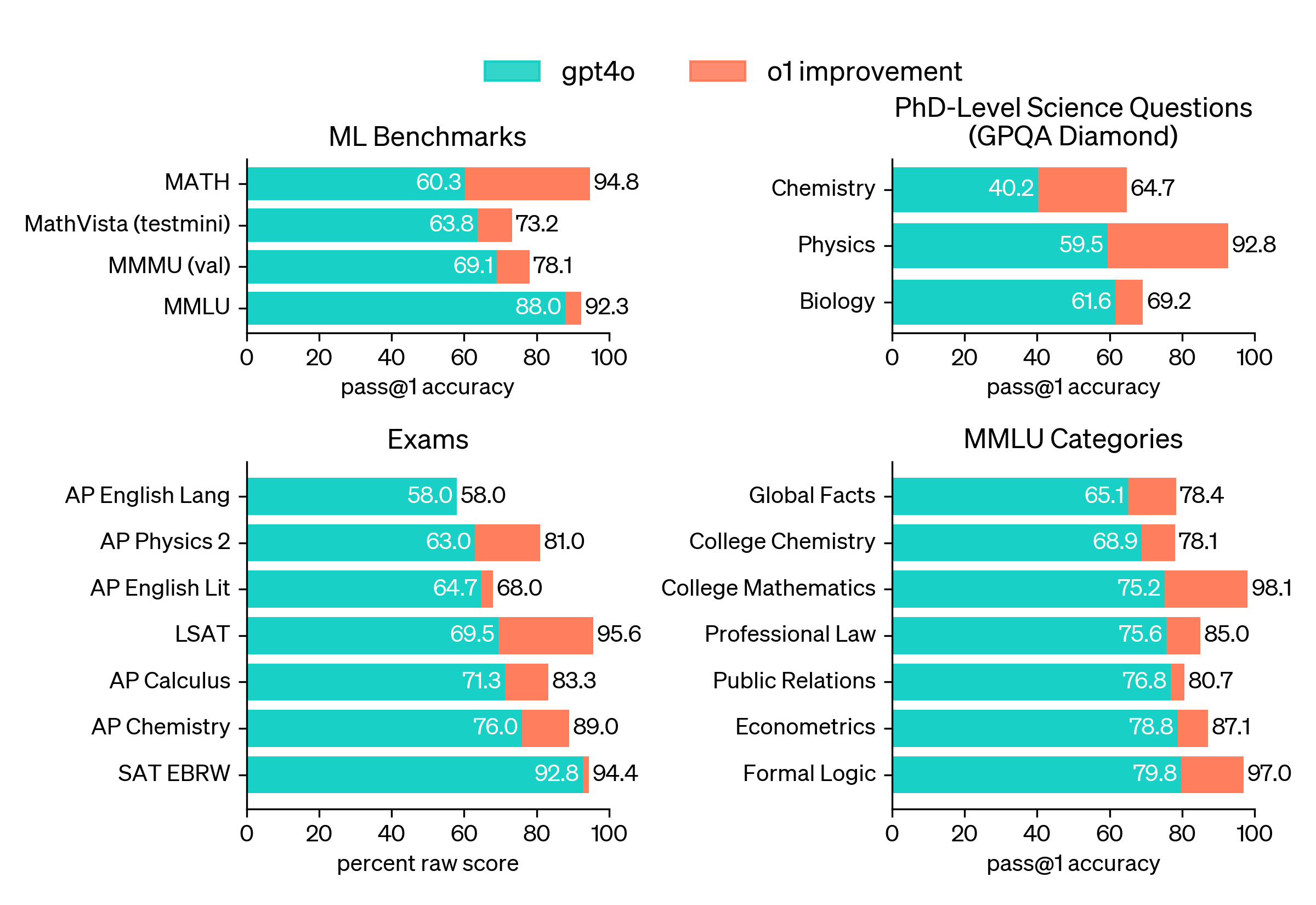
Introduction
OpenAI’s o1 series represents a significant leap forward in AI reasoning capabilities. These models, including o1-preview and o1-mini, are designed to tackle complex problems through advanced reasoning. This guide will explore how to effectively prompt these models, highlight their strengths across various domains, and provide practical examples to help you maximize their potential.
Understanding o1 Models
Internal Reasoning Mechanisms
o1 models employ a unique “think before answering” approach, generating internal chains of thought before producing a response. This process involves:
-
Token Generation: The model produces “reasoning tokens” that are not directly visible in the output.
-
Context Analysis: These tokens are used to analyze the prompt and consider multiple approaches.
-
Response Formulation: After the internal reasoning process, the model generates the visible output.
Understanding this mechanism is crucial for crafting prompts that effectively leverage the model’s reasoning capabilities.
Key Characteristics:
-
Internal chain-of-thought processing
-
Discarding of reasoning tokens after completion
-
Larger context window (128,000 tokens)
-
Variable response times based on problem complexity
-
Specialization:
-
o1-preview: Broad reasoning with general knowledge
-
o1-mini: Focused on coding, math, and science tasks
Limitations
-
Beta Status: Limited features and access
-
No Multimodal Input: Text-only, no image processing
-
Limited API Parameters: No streaming, function calling, or custom instructions
Internal Structure and Principles of o1
Architectural Overview
The o1 series is built upon a novel architecture that extends the transformer model with additional components designed specifically for reasoning:
-
Reasoning Encoder: Processes input and generates initial reasoning tokens.
-
Thought Propagation Network: Allows for iterative refinement of reasoning.
-
Decision Gate: Determines when sufficient reasoning has occurred.
-
Output Decoder: Generates the final response based on reasoning outcomes.
Key Principles
-
Dynamic Reasoning Depth: Unlike previous models with fixed processing steps, o1 can adjust the depth of its reasoning based on problem complexity.
-
Abstraction and Concretization: o1 can move between abstract concepts and concrete examples fluidly, mimicking human cognitive processes.
-
Multi-Perspective Analysis: The model can simultaneously consider multiple viewpoints or approaches to a problem.
-
Metacognition Simulation: o1 has a rudimentary ability to “think about thinking,” allowing it to assess and adjust its own reasoning process.
-
Temporal Reasoning: The model can handle complex temporal relationships, essential for tasks involving causality and prediction.
The Reasoning Process
-
Initial Encoding: The input is processed through the reasoning encoder, generating initial thought tokens.
-
Iterative Refinement: The thought propagation network repeatedly processes these tokens, refining and expanding the reasoning.
-
Convergence Check: The decision gate assesses whether the reasoning has reached a sufficient depth or clarity.
-
Response Generation: Once the decision gate is satisfied, the output decoder synthesizes the reasoning into a coherent response.
This process allows o1 to tackle problems with a depth and nuance previously unattainable in AI systems.
Effective Prompting Strategies
Keep It Simple and Direct
o1 models excel with clear, concise instructions. Avoid overcomplicating your prompts with unnecessary context or instructions.
Example:
Bad: "I want you to act as an expert physicist and carefully consider step-by-step how to solve this problem about quantum entanglement. Think through each stage of the solution methodically."
Good: "Explain quantum entanglement and its implications for quantum computing."
Avoid Chain-of-Thought Prompts
The o1 models perform internal reasoning, so explicit instructions to “think step-by-step” are unnecessary and may hinder performance.
Example:
Bad: "Think step-by-step about how to optimize a neural network for image classification. First, consider the architecture, then the loss function, then the optimization algorithm..."
Good: "Describe the process of optimizing a neural network for image classification."
Use Clear Delimiters
Employ delimiters like triple quotation marks, XML tags, or section titles to clearly separate different parts of your input.
Example:
Analyze the following poem:
"""
Two roads diverged in a yellow wood,
And sorry I could not travel both
And be one traveler, long I stood
And looked down one as far as I could
To where it bent in the undergrowth;
"""
Provide:
1. A summary of the poem's meaning
2. An analysis of its literary devices
3. The poem's historical context
Limit Additional Context in RAG
When using retrieval-augmented generation, include only the most relevant information to prevent overcomplication.
Example:
Bad: [Includes entire Wikipedia article on climate change]
"Summarize the key points about climate change mitigation strategies."
Good: [Includes brief excerpts on mitigation strategies]
"Summarize the key points about climate change mitigation strategies based on this information."
Advanced Prompting Techniques
1. Precision in Problem Framing
Unlike previous models where verbose instructions could be beneficial, o1 models thrive on concise, well-defined problem statements.
Example:
Instead of: "Can you help me understand the implications of quantum entanglement on modern cryptography? Please explain step by step."
Use: "Analyze the impact of quantum entanglement on post-quantum cryptography."
This approach allows the model to leverage its internal reasoning without unnecessary constraints.
2. Leveraging Domain-Specific Language
o1 models excel when presented with prompts that use terminology and concepts specific to the field in question. This primes the model to operate within the appropriate context.
Example for a physics problem:
"Using the principles of Lagrangian mechanics, derive the equations of motion for a double pendulum system."
3. Multi-Perspective Prompting
For complex issues, encourage the model to consider multiple viewpoints or methodologies.
Example:
"Evaluate the ethical implications of CRISPR gene editing technology from utilitarian, deontological, and virtue ethics perspectives."
4. Iterative Problem Decomposition
For highly complex tasks, break them down into subtasks and use the model iteratively.
Example:
1. "Outline the key components of a quantum computer."
2. "For each component identified, explain its function and current technological limitations."
3. "Synthesize this information to project the timeline for achieving quantum supremacy in cryptography."
5. Constraint-Based Prompting
Provide specific constraints or requirements to guide the model’s reasoning process.
Example:
"Design a sustainable urban transportation system for a city of 5 million people. Constraints:
- Must reduce carbon emissions by 50% within 10 years
- Cannot exceed current transportation budget by more than 20%
- Must improve accessibility for disabled residents by 30%"
Maximizing o1’s Capabilities Across Domains
1. Scientific Research and Analysis
o1 models excel in scientific reasoning, making them powerful tools for researchers and analysts.
Techniques:
-
Literature Review Synthesis: Use o1 to analyze and synthesize findings from multiple research papers.
-
Hypothesis Generation: Leverage o1’s reasoning to generate novel hypotheses based on existing data.
-
Experimental Design: Utilize o1 to design robust experimental protocols.
Example prompt:
"Based on recent advancements in CRISPR technology, propose three novel experimental approaches to target antibiotic-resistant bacteria. For each approach, outline the methodology, potential risks, and expected outcomes."
2. Advanced Mathematics and Theoretical Physics
The o1 series demonstrates exceptional capabilities in complex mathematical and physics problems.
Techniques:
-
Proof Validation: Use o1 to check the logic and steps of mathematical proofs.
-
Concept Bridging: Employ o1 to explain connections between seemingly disparate mathematical or physical concepts.
-
Problem Reformulation: Leverage o1 to reframe complex problems in more solvable terms.
Example prompt:
"Explain the connection between the Riemann Hypothesis and the distribution of prime numbers. Then, propose a novel approach to prove the Riemann Hypothesis using techniques from algebraic geometry."
3. Software Engineering and Algorithm Design
o1-mini, in particular, excels in coding tasks and algorithm development.
Techniques:
-
Code Optimization: Use o1 to analyze and optimize complex algorithms.
-
Architecture Planning: Leverage o1 to design scalable software architectures.
-
Bug Prediction: Employ o1 to identify potential vulnerabilities in code structures.
Example prompt:
"Design a distributed system architecture for a real-time financial trading platform that can handle 1 million transactions per second. Include considerations for data consistency, fault tolerance, and regulatory compliance."
4. Strategic Business Analysis
o1’s reasoning capabilities make it a powerful tool for complex business strategy formulation.
Techniques:
-
Scenario Planning: Use o1 to generate and analyze multiple future business scenarios.
-
Competitive Analysis: Leverage o1 to perform in-depth competitor analysis and market positioning.
-
Risk Assessment: Employ o1 to identify and quantify potential business risks.
Example prompt:
"Develop a 5-year strategy for a mid-size technology company to enter the quantum computing market. Include analysis of potential competitors, required R&D investments, and go-to-market strategies. Identify key risks and propose mitigation measures."
5. Ethical and Philosophical Reasoning
The o1 series can engage in nuanced ethical and philosophical discussions.
Techniques:
-
Argument Mapping: Use o1 to create comprehensive maps of complex philosophical arguments.
-
Ethical Dilemma Analysis: Leverage o1 to analyze ethical dilemmas from multiple philosophical perspectives.
-
Concept Evolution Tracing: Employ o1 to trace the historical development of philosophical concepts.
Example prompt:
"Analyze the trolley problem from utilitarian, deontological, and virtue ethics perspectives. Then, apply this ethical framework to the development of autonomous vehicle decision-making algorithms."
Techniques for Specific Use Cases
1. Policy Analysis and Development
Leverage o1’s reasoning capabilities to analyze complex policy issues and develop comprehensive policy proposals.
Technique: Multi-stakeholder Impact Analysis
Example prompt:
"Analyze the potential impacts of implementing a universal basic income in the United States. Consider economic, social, and political implications. Identify key stakeholders and predict their responses. Propose a phased implementation plan that addresses potential challenges."
2. Scientific Theory Development
Utilize o1 to assist in the development and refinement of scientific theories.
Technique: Cross-disciplinary Synthesis
Example prompt:
"Develop a unified theory that bridges quantum mechanics and general relativity. Identify key obstacles in current theories, propose novel approaches to overcome them, and predict potential experimental validations for your proposed theory."
3. Advanced Financial Modeling
Employ o1 for complex financial analysis and prediction.
Technique: Multi-factor Scenario Modeling
Example prompt:
"Create a comprehensive financial model for a multinational corporation considering expansion into emerging markets. Factor in geopolitical risks, currency fluctuations, and potential regulatory changes over the next decade. Provide a sensitivity analysis for key variables."
4. AI Ethics and Governance
Leverage o1 to tackle complex issues in AI ethics and develop governance frameworks.
Technique: Ethical Framework Development
Example prompt:
"Develop a comprehensive ethical framework for the development and deployment of autonomous AI systems. Address issues of accountability, transparency, fairness, and potential long-term societal impacts. Propose specific governance structures and regulatory approaches."
5. Climate Change Mitigation Strategies
Utilize o1’s reasoning to develop innovative approaches to combat climate change.
Technique: Systems-level Solution Design
Example prompt:
"Design a global strategy to achieve net-zero carbon emissions by 2050. Include technological innovations, policy recommendations, economic incentives, and behavior change initiatives. Address potential obstacles and propose solutions for equitable implementation across developed and developing nations."
Optimizing Performance and Managing Limitations
1. Context Window Management
With a 128,000 token context window, effective management is crucial for optimal performance.
Strategies:
-
Prioritize recent and relevant information
-
Use concise language to maximize available space
-
Implement a token-tracking system in your application
2. Handling Long Response Times
o1 models may take longer to respond due to extensive internal reasoning.
Strategies:
-
Implement asynchronous processing in your applications
-
Provide user feedback on processing status
-
Use o1-mini for tasks requiring faster response times
3. Iterative Refinement
For complex tasks, use an iterative approach to refine outputs.
Technique: Progressive Elaboration
-
Start with a high-level prompt
-
Analyze the initial response
-
Follow up with more specific prompts based on the initial output
-
Repeat steps 2-3 until the desired level of detail is achieved
Example:
Initial Prompt: "Outline a strategy to mitigate supply chain disruptions in the semiconductor industry."
Follow-up: "Based on the outlined strategy, detail specific technological investments needed to increase supply chain resilience."
Further Refinement: "Provide a cost-benefit analysis for implementing the proposed technological investments over a 5-year period."
Ethical Considerations and Best Practices
1. Bias Mitigation
While o1 models demonstrate improved performance in many areas, they may still perpetuate biases present in their training data.
Best Practices:
-
Regularly audit outputs for potential biases
-
Use diverse perspectives in prompt formulation
-
Implement human oversight for sensitive applications
2. Factual Accuracy
Despite advanced reasoning capabilities, o1 models can still produce inaccurate information.
Best Practices:
-
Implement fact-checking protocols for critical information
-
Use o1 models in conjunction with verified data sources
-
Maintain transparency about the AI-generated nature of the information
3. Responsible Deployment
Consider the broader implications of deploying o1 models in various domains.
Guidelines:
-
Assess potential societal impacts before deployment
-
Implement robust security measures to prevent misuse
-
Develop clear usage policies and ethical guidelines for your organization
Future Directions and Ongoing Research
As o1 models continue to evolve, stay informed about:
-
Advancements in multimodal capabilities
-
Improvements in reasoning transparency
-
Integration with external tools and knowledge bases
Engage with the AI research community to:
-
Contribute to benchmark development
-
Participate in responsible AI initiatives
-
Explore novel applications of reasoning AI models
Conclusion
The OpenAI o1 series represents a significant advancement in AI reasoning capabilities. By understanding its unique characteristics and applying advanced prompting techniques, users can leverage these models to tackle complex problems across various domains. As with any powerful technology, responsible use and ongoing ethical consideration are paramount.
As we continue to explore the possibilities of o1 and future iterations, we stand at the forefront of a new era in artificial intelligence – one where machines don’t just process information, but engage in sophisticated reasoning to solve some of humanity’s most pressing challenges.




















